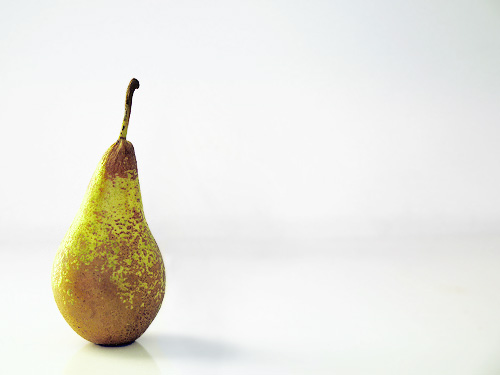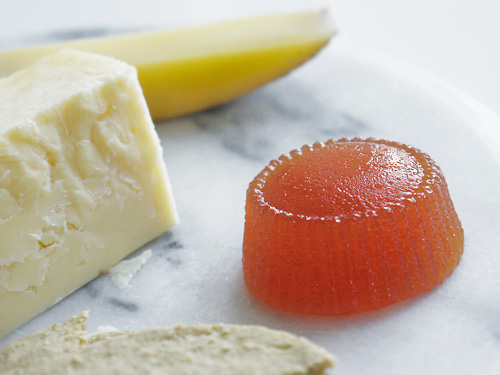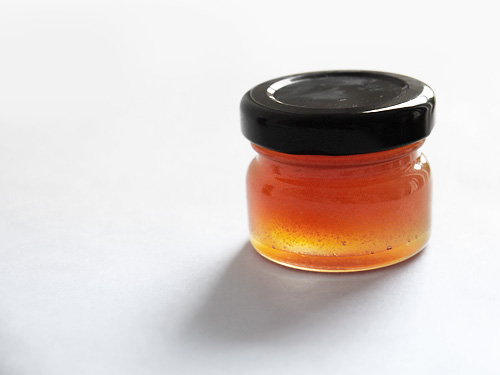I recently made a batch of pear jelly and I’ve been amazed how popular it has been. I was also incredibly excited when I saw that it had even inspired people to make it and do their own posts, like on Things {We} Make. I love to look at blogs and use them as a source of inspiration, and it’s great to think that people may be looking at what I get up to for the same reason.
When I saw their version of pear jelly, I did get a little bold and hinted to them that I had another pear recipe in the offing. Well, finally, here it is – perada!
So first of all, a bit of context. What is perada?
If you’ve got a soft spot for Spanish food, then you’re probably familiar with membrillo, the rich red quince paste that is famously paired with manchego cheese. Perada is something similar, although less familiar (at least to me). I came across this idea a while ago and it was mentally filed away in the “to try at some point” part of my brain.
Well, since I made the pear jelly, I received yet another bag of windfall pears. A slightly different variety, which my limited garden knowledge had identified as Williams. While it would be interesting to have pear jelly made with different varieties of pear so that I can then express a preference when called upon to do so, there is also an overwhelming need to be practical. With the best will in the world, there is a limit to just how much jam and jelly a household can consume over a year, so I did two things. Firstly, I left some of the pears wrapped in newspaper to ripen for a week (a tip from Lynn at Queen of the Castle – thanks!). Second, I dug out the old recipe and use the rest to make – surprise! – a batch of perada.
The interesting thing is that there does not seem to be too much on this item on the beloved web. A couple of sources refer to it as being Iberian in origin. Beyond that, there is not much to find, so it is clearly playing second fiddle to the more famous membrillo. So let’s see if we can do a little to change that, shall we?
The method is quite easy – you boil the pears, peel them while warm, then mash them up and pass through a sieve. I have to admit, I was pretty dubious that this would work, and feared all manner of stringy bits and pips in the resulting puree, but it worked like an absolute dream. So if you’re tempted to get into all the fuss of de-coring the pears, you don’t have to.
As with my pear jelly, the colour was a bit of a surprise. The pear puree came out as a pale yellow colour, and I was expecting something similar from the resulting perada. But no. As you can see below, once the sugar was added and the whole lot allowed to boil up, it turned a rich amber colour.
Now, you may remember that on previous occasions I seemed to rant a little against the use of pectin. Well, it’s not that I’m actually against it – it is just that I tend to use high-pectin fruits, or I just add lemons, which also add a nice tang. However, with this recipe, I wanted to keep the cooking time to a minimum so as to benefit from maximum fruity pear flavour. I was also keen to have perada that would set in funky moulds I was using, and that could be sliced easily into delicate slivers to perch atop pieces of cheese.
With the perada mixture made, it was time to store it. I filled one normal ramekin, four miniature moulds to adorn a cheeseboard, and I also filled three miniature jam pots to store for Christmas. To say that I was surprised at how little I got out of the process was something of an understatement! But highly predictable given that you need to let the mixture cook, and cook, and cook until it reduces down.
To make my miniature portions of perada, I got a little bit cunning, and as you can see from the picture below, they look like a proper old-fashioned jelly or blancmange. Well, there is a little trick to this. I used a silicone cupcake mould, then turned it inside-out. This results in a little ring of dimples at the top of the perada, which I think looks rather cute.
You can also see that once it has been sliced, the true colour is apparent – more of an amber colour than red, which I think does look rather jaunty indeed on a piece of cheese.
Lacking any manchego in the house, I paired it with a very mature Cornish cheddar, and was frankly delighted with the combination. The perada is sweet, but the cheese was very strong and tangy, and the two together was just a little piece of joy. Given that both pears and cheddar are very typically British, it is a combination that sounds odd but does work.
Once you have gone to all the effort of making perada, you might wonder what to do with it all. The natural home for it is as part of a cheeseboard, but there is of course a natural limit to just how much cheese you can eat. But perada is adaptable – cut into pieces and coat in sugar to make little pâtes de fruits, or use chunks of it in cakes or pastries.
Alternatively, be sure to do as I did, and put some perada into little jam jars – this allows you to store it and use it from time to time, enjoying the fruits of your labour over the winter months.
To make perada:
• 8 pears (leave the skin on)
• 300g white sugar
• 130ml water
• juice of 1/2 lemon
• 4 strips lemon peel, optional (*)
• 3 tablespoons liquid pectin, optional(**)
Rinse the pears, place in a saucepan and cover with cold water. Bring to the boil, then leave to simmer on a gentle heat until soft. They are ready when a sharp knife can be easily inserted (20-30 minutes).
Drain the pears. Once cool enough to handle, peel the pears and discard the skin.
Put the pears into a sieve above a bowl, and use the back of a spoon to push them through. You will end up with a bowl of pear puree and all the stringy bits and pips in the sieve.
Measure the pear puree, and add 3/4 by volume of sugar to the mixture (i.e. for every 1 cup of pear puree, add 3/4 cup sugar).
Put the pear puree, sugar, water, lemon juice and lemon peel strips into a saucepan. Bring to the boil, cook for a minute (stirring as needed) and then reduce to a simmer. Stir in the liquid pectin (if using) and then cook for around an hour until the mixture is thick and leaves little “trails” on the bottom of the pan that take a second or two to cover over. Worry less about the cooking time, and more about when the perada reaches the right thickenss. You can also test it by dropping a small amount onto a very cold plate – if it goes firm after a minutes, the perada is ready.
Remove the lemon peel. Pour the cooked perada into moulds or sterile jam jars(***).
(*) Adding the lemon peel gives the perada a slight lemon aroma. Optional, but a nice touch.
(**) You can use the perada as a paste, or add the pectin to ensure that it sets firmly and can be cut. The pectin is essential if you want to make all these fancy shapes or cut into pieces.
(***) If using moulds, use a tiny amount of neutral oil to rub the inside so that the perada slips out. And I really mean a tiny amount – it should look invisible.
Worth making? This is an interesting but very simple recipe. It takes a little time to make, but it a good idea for when you’re mooching around the house at the weekend. Well worth trying.









